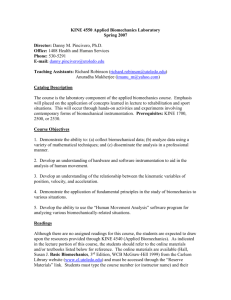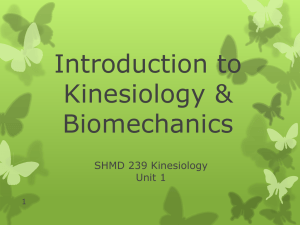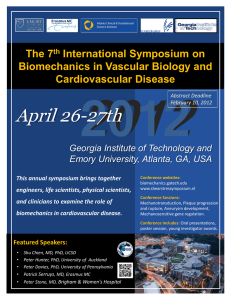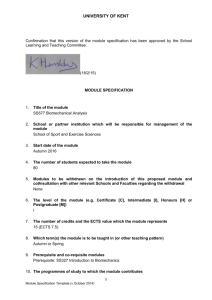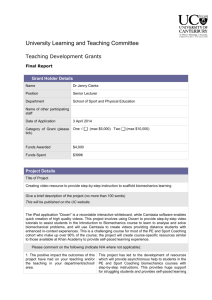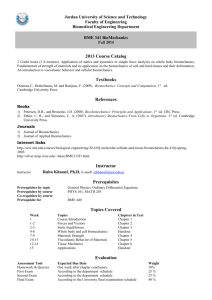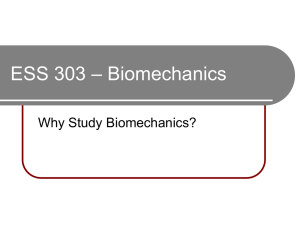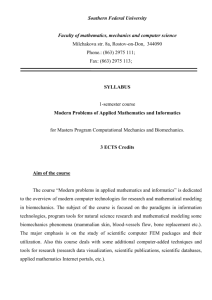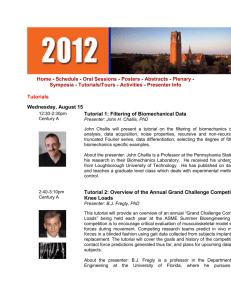3650F03 - University of Lethbridge
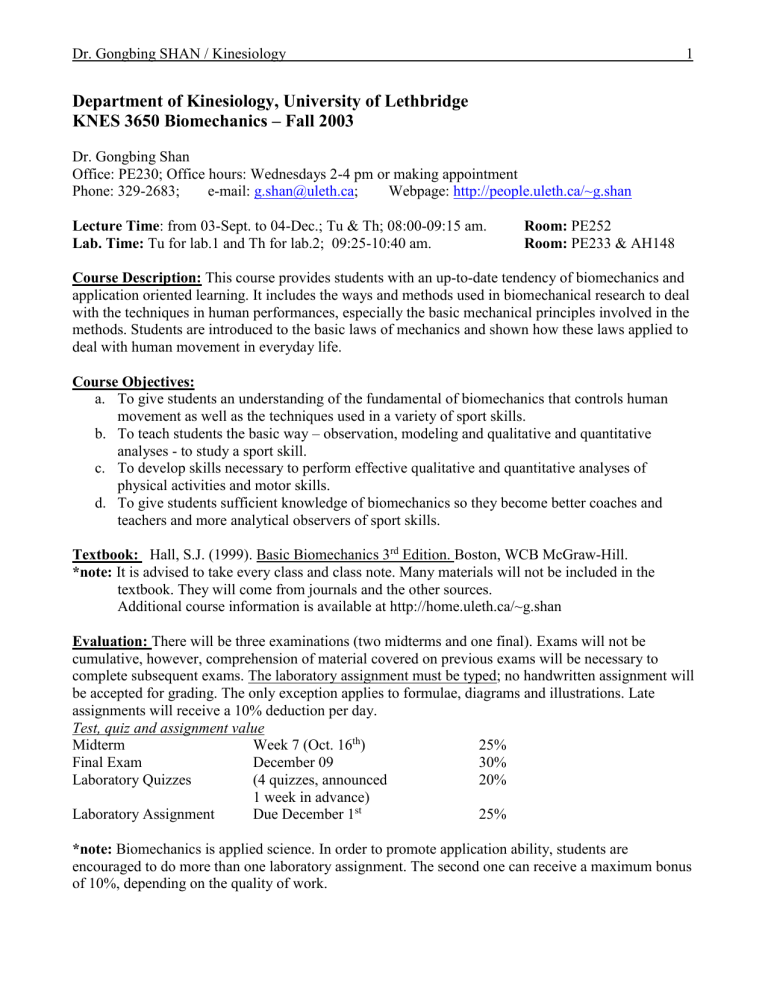
Dr. Gongbing SHAN / Kinesiology 1
Department of Kinesiology, University of Lethbridge
KNES 3650 Biomechanics – Fall 2003
Dr. Gongbing Shan
Office: PE230; Office hours: Wednesdays 2-4 pm or making appointment
Phone: 329-2683; e-mail: g.shan@uleth.ca
; Webpage: http://people.uleth.ca/~g.shan
Lecture Time
Lab. Time:
: from 03-Sept. to 04-Dec.; Tu & Th; 08:00-09:15 am.
Tu for lab.1 and Th for lab.2; 09:25-10:40 am.
Room: PE252
Room: PE233 & AH148
Course Description: This course provides students with an up-to-date tendency of biomechanics and application oriented learning. It includes the ways and methods used in biomechanical research to deal with the techniques in human performances, especially the basic mechanical principles involved in the methods. Students are introduced to the basic laws of mechanics and shown how these laws applied to deal with human movement in everyday life.
Course Objectives: a.
To give students an understanding of the fundamental of biomechanics that controls human movement as well as the techniques used in a variety of sport skills. b.
To teach students the basic way – observation, modeling and qualitative and quantitative analyses - to study a sport skill. c.
To develop skills necessary to perform effective qualitative and quantitative analyses of physical activities and motor skills. d.
To give students sufficient knowledge of biomechanics so they become better coaches and teachers and more analytical observers of sport skills.
Textbook: Hall, S.J. (1999). Basic Biomechanics 3 rd
Edition. Boston, WCB McGraw-Hill.
*note: It is advised to take every class and class note. Many materials will not be included in the textbook. They will come from journals and the other sources.
Additional course information is available at http://home.uleth.ca/~g.shan
Evaluation: There will be three examinations (two midterms and one final). Exams will not be cumulative, however, comprehension of material covered on previous exams will be necessary to complete subsequent exams. The laboratory assignment must be typed; no handwritten assignment will be accepted for grading. The only exception applies to formulae, diagrams and illustrations. Late assignments will receive a 10% deduction per day.
Test, quiz and assignment value
Midterm
Final Exam
Week 7 (Oct. 16 th
)
December 09
25%
30%
20% Laboratory Quizzes (4 quizzes, announced
1 week in advance)
Due December 1 st
Laboratory Assignment 25%
*note: Biomechanics is applied science. In order to promote application ability, students are encouraged to do more than one laboratory assignment. The second one can receive a maximum bonus of 10%, depending on the quality of work.
Dr. Gongbing SHAN / Kinesiology 2
Grade Scheme: Grades will be assigned based on the following grading scheme. In all cases marks will be rounded to the nearest whole number.
Letter Grade Percentage GPA
A+ 91-100% 4.0
A
A-
86%-90.9%
80-85.9%
4.0
3.7
B+
B
B-
77-79.9% 3.3
73-76.9% 3.0
70-72.9% 2.7
Letter Grade Percentage GPA
C+
C
C-
D+
D
F
67-69.9%
63-66.9%
60-62.9%
55-59.9%
50-54.9%
0-49.9%
2.3
2.0
1.7
1.3
1.0
0
Tentative Course Schedule: Class sessions and laboratories will combine to provide the skills and knowledge of the biomechanical principles necessary for the successful class completion, as outlined below under Topics.
Readings Laboratory Week
Week 01
Topic
Introduction; class requirements and expectations; explanation and discussion of tests; explanation and discussion of lab assignment.
Introduction to Biomechanics
Ch1 No Lab
Week 02 Terminology , and methodological approaches Ch1 Principle of motion analysis I
Week 03 Basic mechanical concepts, Force diagrams & vectors 62-71,81-89
Week 04 Forces and Movement
67-69, 396-401,
403-410, 417-434,
497-498, 510-514
Principle of motion analysis II
Force Measurement
Week 05 Torque and lever like arrangements
Week 06
71-72,436-475
Lever like arrangements continued, Balance and Stability
465-469
Week 07
Linear Kinematics, Linear momentum
Midterm
326-341,411-416
Students’ measurements I
Students’ measurements II
Data analysis – HUMAN I
Week 08 Projectile motion 341-361
Week 09 Angular kinematics
Week 10 Angular momentum
368-390,476-482
482-494
Data analysis – HUMAN II
Center of Mass-Segmental
Method
Analysis of Angular Motion
Week 11 Analysis of Throw and push like movement patterns ---
Simulation of selected sport skills
Week 12
Fluid dynamics
Aerodynamics in Sport
Week 13
Analysis of activities in which the body rotates free of support and while supported
465-495
---
Question section for lab report
Question section for lab report
Week 14 Summary ---
Lab Report Due (Dec. 1 st ,
Mon. 5:00pm)
Dec 09
Final Exam 2:00 – 5:00 pm
Dr. Gongbing SHAN / Kinesiology
The lecture is based on the following reference Books:
Duck, Tom (2000)
HU-M-AN (Human Movement Analysis)
HMA Technology Inc.
Enoka, Roger M. (1994)
Neuromechanical Basis of Kinesiology (Second Edition)
ISBN: 0-87322-665-8
Hall, S.J. (1999).
Basic Biomechanics (Third Edition)
ISBN: 0-07-092118-0
Hay, James G. (1993)
The Biomechanics of Sports Techniques (Fourth Edition)
ISBN: 0-13-084534-5
Hochmuth, Gerhard (1984)
Biomechanics of Athletic movement
ISBN: 3-5057-00081-6313
Kreighbaum, Ellen & Barthels, Hatharine M. (1996)
Biomechanics – A qualitative approach for studing human movement
ISBN: 0-205-18651-3
Saziorski, W. M., Aruin, A. S. and Selujanow W. N. (1984)
Biomechanik des menschenlichen Bewegungsapparates
Lizenznummer: 140 355/3/84
Shan, Gongbing (1999)
Ein biomechanisches Modell auf Basis von individuellen anthropometrischen Daten fuer das Bewegungslernen von
Flugphasen bei sportlichen Bewegungsablaeufen
ISBN: 3-8258-4274-6
Willimczik, Klaus (HG.) (1989)
Biomechanik der Sportarten
ISBN: 3-499-18601-2
3
